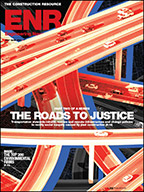If you want an early briefing of the U.S. Army Corps of Engineers’ new, National Levee Database, register soon because there are only 120 spaces available for each of three webinars that have been scheduled to introduce it, starting Oct. 27.
The Corps is announcing public access to the NLD, a dynamic information source that provides, for the first time, map-based visualization and search capabilities for the location and condition of levee systems nationwide. Developed by engineers and scientists, it is said to have a "distinctly technical feel."
There will be at least two levels of access, one, will make available about 95% of the data as information for the general public. But because of Department of Homeland Security restrictions, access to the additional 5% of more sensitive information will be limited to government and public safety officials.
“Executive summaries of systems will be there, but the public may not have access to reports with specific deficiencies,” says Eric C. Halpin, the USACE special assistant for dam and levee safety. “Security specialists and DHS tell us the bad guys still consume the most important information from the Internet.”
The database can be found at http://nld.usace.army.mil.
Site users will be able to learn about attributes of specific levees and floodwalls that are relevant to flood fighting, design, construction, operation, maintenance, repair, inspection and potential for failure.
The system requires data on certain minimum attributes to ensure nationwide consistency, but it also includes many optional fields useful for informing local or regional levee management decisions.
In addition, the NLD contains population data, which will allow for the assessment of the potential life loss and economic and property consequences of any overtopping or breach.
More than 14 million people live behind levees that are under Corps authority.
“The National Levee Database is intended to be an authoritative source for information on levees nationally; very similar to the national registry of dams,” says Halpin.




Post a comment to this article
Report Abusive Comment